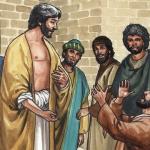From Israel and the West Bank: good news and bad news. First, the good news: Israeli courts have indicted two men for last month’s arson attack on the Church of the Multiplication of Loaves and Fishes, at Taghba. Second, the Israeli government has officially declared a similar attack in the Palestinian village of Duma, an act of terror.
The bad news: Swelling messianic fervor among Jewish sedevacantists and crunchy cons on steroids may lead to even more violence.
The Duma attack, which occurred last Friday, claimed the life of 18-month-old Ali Dawabsheh and left his father, Saad, and his mother, Riham, badly burned.
In classifying the Duma attack as an act of terror, Israel’s Security Council has enabled the surviving victims to claim benefits from the Israeli government. It has also granted courts the right to place suspects in “administrative detention.”
To this point, “price-tag” attacks – acts of violence committed against Christians, Palestinians and their property to protest the dismantling of settlements by the government – have been classified as “unlawful associations,” one step down from terrorism. This classification gives courts the right to effectively banish suspects from the Occupied Territories, and to prevent them from conferring with their attorneys.
No suspects have yet been charged in the Duma attack.
Despite the long-standing presence of a violent fringe within the settler movement, the regular practice of “price-tagging” is relatively new, emerging only after the Israeli government’s “disengagement” from Gaza, which included the forcible removal of settlers. Typically, attacks involve vandalism or arson, or the destruction of crops grown by Palestinians and Israeli Arabs. Along with last summer’s kidnapping and murder of 16-year-old Palestinian Muhammad Abu Khdeir, the Duma attack appears to mark a new low.
The men indicted for the Taghba burning, as well as two other men and a minor who have been arrested but not yet charged, are Orthodox Jews who have lived at various times in West Bank settlements. All reportedly subscribe to an extreme form of religious Zionism, which dignifies redemption of the historical land of Israel – including the West Bank, Gaza Strip and Golan Heights – as God’s supreme commandment, and a means of hastening the messiah’s arrival.
Twenty-year-old Yinon Reuveni, indicted along with 19-year-old Yehuda Asraf, is also a suspect in last February’s arson attack on Dormition Abbey. Both are said to belong to the “hilltop youth,” a loose network of young settlers that rejects the authority of the Yesha Council, and which follows, in the words of The Jewish Daily Forward’s J.J. Goldberg, “a syncretic philosophy combining religious Orthodoxy, far-right politics and new-age environmentalism.”
Spokespeople for Shin Bet, Israel’s security agency, report that all five suspects are members of an unnamed organization determined to “overturn the government and bring about messianic rule.”
Along with the use of fire, the Duma and Taghba attacks have in common Hebrew messages spray-painted near the crime scenes. The Taghba graffiti read: “The false gods will surely be uprooted.” At Duma, on a wall near the Dawabsheh home, two messages were spray-painted: “Revenge” and “Long-live the messiah-king.”
According to Goldberg, “Revenge” may mark the attack as retaliation for the government’s demolition of two buildings raised by Jewish settlers illegally at Beit El. However, he says, as the message is more strident than usual, and the violence itself more deliberately brutal, it may connect the killing with the murder of settler Malachi Moshe Rosenfeld, by Palestinians, just 30 days earlier.
Goldberg further suggests that “Long live the messiah-king,” like “The false gods will surely be uprooted,” reveals the influence of a messianic wing within the Hasidic Chabad-Lubavitch sect. Taking “Long live the messiah-king” for their motto, messianic Lubavitchers believe the sect’s last rebbe, Menachem Mendel Schneerson, who died in 1996, to have been the messiah whose triumphant appearance was prophesied in the Old Testament.
“The false idols will surely be uprooted” is taken from the Aleinu prayer. Recited at the end of each of the three daily services observed by religious Jews, the Aleinu foretells a messianic age where the wicked will be punished, and the entire world will submit to God’s authority.
Goldberg stresses, however, that any connection between the two attacks – and between the attacks and Chabad — remains strictly in the realm of speculation. Messianic-minded hilltop youth might attach themselves to any number of spiritual camps, including the followers of the late Rabbi Meir Kahane and the followers of the Bratslaver Rebbe, dead since 1810.
“It’s been noted in recent years,” he writes, “mostly but not only in jest, that the three movements — Chabad, Bratslav and Kahanist — are all led by dead rebbes who aren’t around to discipline their more eccentric followers.”















